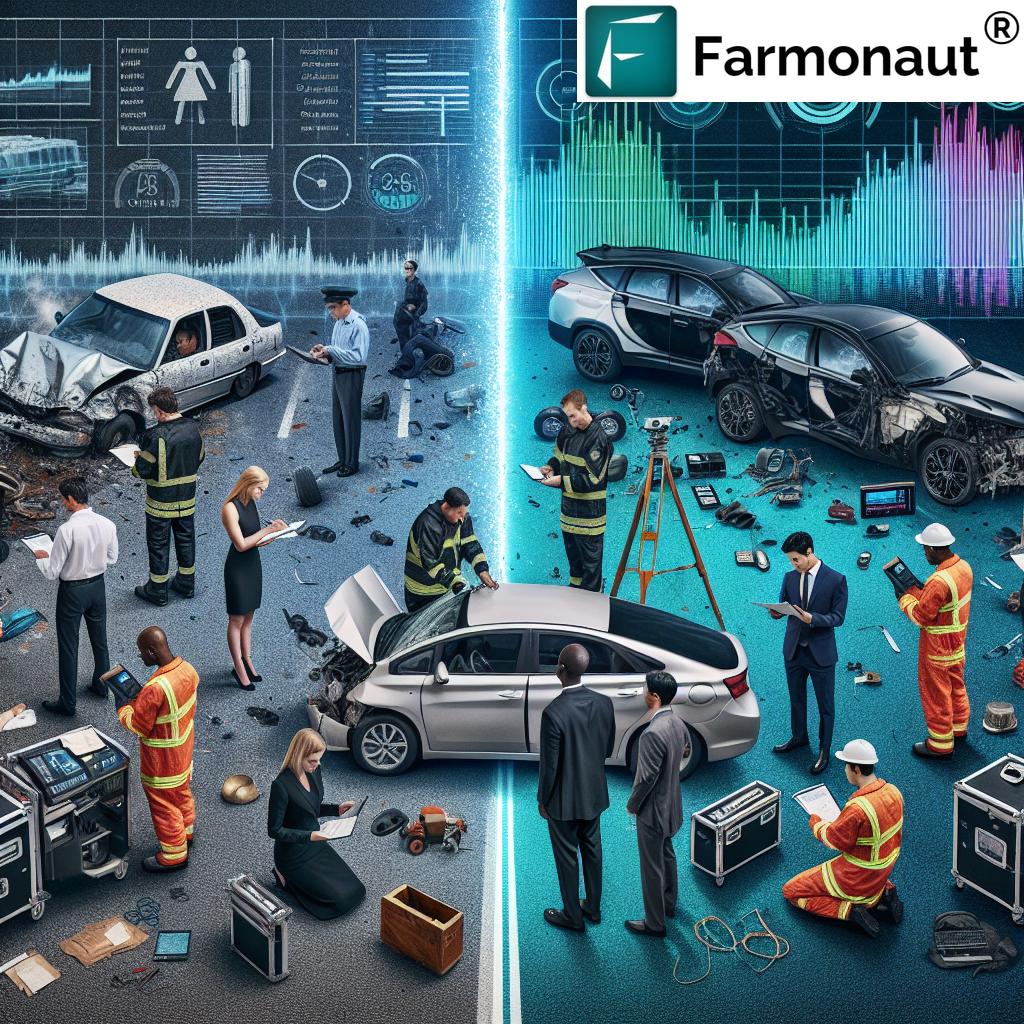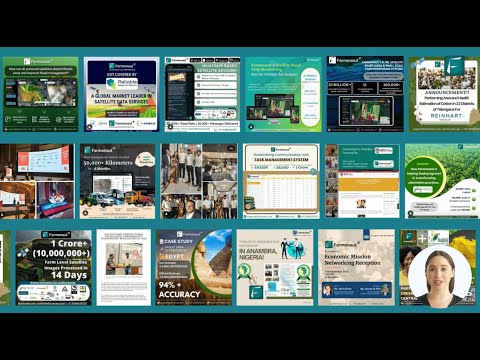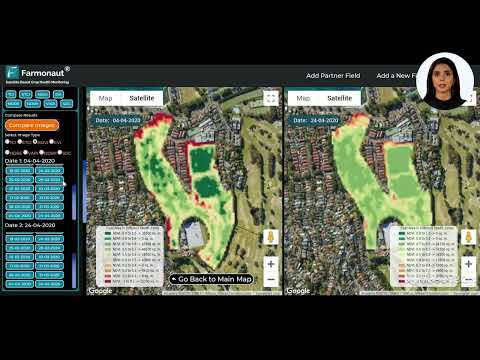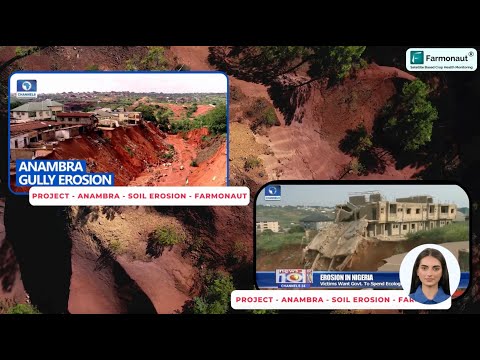Federal Safety Regulations and Autonomous Vehicle Oversight: Navigating the Future of Transportation Technology
In the rapidly evolving landscape of transportation technology, we find ourselves at a critical juncture where federal automotive safety regulations and autonomous vehicle oversight are shaping the future of how we move. As experts in the field of agricultural technology, we at Farmonaut understand the profound impact that innovative technologies can have on traditional industries. While our focus is on revolutionizing farming practices through satellite-based solutions, we recognize the parallels between the agricultural and automotive sectors in terms of technological advancement and regulatory challenges.
In this comprehensive analysis, we’ll explore the intricate dance between government agencies and car manufacturers, particularly focusing on the electric vehicle industry and the development of self-driving car technology. We’ll delve into the potential consequences of shifting federal transportation policies on vehicle crash investigations and the regulatory process that governs our roads.

“The National Highway Traffic Safety Administration investigates over 100 automated driving system defects annually.”
The Regulatory Landscape: A Balancing Act
The National Highway Traffic Safety Administration (NHTSA) stands at the forefront of vehicle safety technology oversight in the United States. This agency, with its modest staff of about 750, wields significant power in setting standards for automated driving systems and investigating potential defects. The NHTSA’s role is crucial in ensuring that as vehicles become more technologically advanced, they remain safe for public use.
However, the regulatory landscape is not without its challenges. The rapid pace of innovation in the automotive industry, particularly in the realm of autonomous vehicles, often outpaces the development of comprehensive regulations. This creates a complex environment where safety, innovation, and regulatory compliance must be carefully balanced.
The Impact of Political Shifts on Automotive Oversight
Recent political changes have brought the relationship between federal regulators and the automotive industry into sharp focus. The potential for significant shifts in federal transportation policy has raised questions about the future of vehicle crash investigations and the overall regulatory process.
Some key areas of concern include:
- The continuity of ongoing investigations into autonomous vehicle crashes
- The future of mandates requiring automakers to report crash data involving self-driving technologies
- The potential relaxation of safety standards for new vehicle technologies
These concerns highlight the delicate balance between fostering innovation and maintaining rigorous safety standards in the automotive industry.
The Role of NHTSA in Shaping Automotive Safety
NHTSA’s influence extends beyond setting safety standards. The agency’s Office of Defects Investigation plays a crucial role in identifying and addressing potential safety issues in vehicles already on the road. This includes the power to launch probes into crashes and seek recalls for safety defects.
Currently, NHTSA is conducting several significant investigations related to autonomous and semi-autonomous driving systems. These investigations are particularly focused on Tesla’s Autopilot and Full Self-Driving features, which have been involved in numerous crashes, some resulting in fatalities.
The Automotive Recall Process: A Critical Safety Measure
The automotive recall process is a vital component of maintaining vehicle safety. When a defect is identified, manufacturers can issue voluntary recalls, or NHTSA can mandate a recall if it determines a safety risk exists. This process has been instrumental in addressing numerous safety issues over the years, potentially saving countless lives.
However, the recall process faces new challenges in the era of autonomous vehicles. Software-based systems can often be updated remotely, blurring the lines between traditional recalls and routine software updates. This raises questions about how to effectively manage and regulate these “over-the-air” updates to ensure they adequately address safety concerns.
The Push for Federal Regulations on Autonomous Vehicles
As self-driving car technology continues to advance, there is a growing call for comprehensive federal regulations specifically tailored to autonomous vehicles. While nearly 30 states have rules governing self-driving cars, the lack of overarching federal guidelines has created a patchwork of regulations that can be challenging for manufacturers to navigate.
The development of federal regulations for autonomous vehicles could have far-reaching implications for the industry, potentially setting standards for:
- Safety testing and certification of autonomous systems
- Data collection and sharing requirements
- Liability and insurance considerations
- Cybersecurity standards for connected vehicles
“Federal automotive safety regulations impact over 17 million new vehicles sold in the US each year.”
The Intersection of Innovation and Regulation
The rapid pace of innovation in the automotive industry presents both opportunities and challenges for regulators. On one hand, new technologies have the potential to dramatically improve vehicle safety and efficiency. On the other hand, these same technologies can introduce new risks that may not be fully understood or accounted for in existing regulatory frameworks.
This dynamic is particularly evident in the development of autonomous vehicles. While self-driving cars hold the promise of reducing human error-related accidents, they also introduce new concerns about software reliability, cybersecurity, and the ethical decisions that must be programmed into these systems.

The Role of Data in Shaping Policy
Data collection and analysis play a crucial role in shaping automotive safety regulations. The mandate for automakers to report crash data involving self-driving and partially automated technologies has provided valuable insights into the performance and limitations of these systems.
However, the future of this data collection mandate is uncertain. Any changes to this requirement could significantly impact our understanding of autonomous vehicle safety and the ability to develop evidence-based regulations.
At Farmonaut, we understand the importance of data-driven decision-making. Our satellite-based farm management solutions rely on robust data collection and analysis to provide valuable insights to farmers. Similarly, the automotive industry and regulators must continue to prioritize data collection and transparency to ensure the safe development of autonomous vehicle technology.
The Impact on Consumers and Public Safety
As we navigate this complex landscape of regulation and innovation, it’s crucial to consider the impact on consumers and public safety. The development of autonomous vehicles holds the promise of reducing traffic accidents and improving mobility for many, including those unable to drive conventional vehicles.
However, public trust in these technologies is paramount. High-profile crashes involving autonomous or semi-autonomous vehicles have raised concerns about the readiness of this technology for widespread adoption. Effective regulation and oversight are essential to building and maintaining public confidence in these systems.
The Global Perspective on Autonomous Vehicle Regulation
The development of autonomous vehicle technology and its regulation is not limited to the United States. Countries around the world are grappling with similar challenges, often taking different approaches to oversight and regulation.
For example:
- The European Union has been working on a comprehensive framework for autonomous vehicle regulation, focusing on issues such as cybersecurity and data protection.
- Japan has been proactive in developing guidelines for autonomous vehicle testing and deployment, with a focus on promoting innovation while ensuring safety.
- China has set ambitious goals for the adoption of autonomous vehicles and has been rapidly developing regulatory frameworks to support this vision.
These global efforts highlight the need for international cooperation and standardization in the regulation of autonomous vehicle technology. As the technology continues to evolve, harmonizing regulations across borders will be crucial for the global automotive industry.
The Role of Industry Self-Regulation
While government oversight is crucial, industry self-regulation also plays an important role in ensuring the safe development of autonomous vehicle technology. Many automakers and technology companies have established their own safety standards and testing protocols that often exceed current regulatory requirements.
This proactive approach by the industry can complement government regulations and help address emerging safety concerns more quickly. However, it’s important to maintain a balance between industry initiative and independent oversight to ensure that public safety remains the top priority.
The Future of Automotive Safety Regulation
As we look to the future, it’s clear that the landscape of automotive safety regulation will continue to evolve. The challenge for regulators and policymakers will be to create frameworks that are flexible enough to accommodate rapid technological advancements while still providing robust protections for public safety.
Some key areas that are likely to shape the future of automotive safety regulation include:
- The development of standardized testing protocols for autonomous vehicles
- The creation of clear guidelines for the transition between human and machine control in semi-autonomous systems
- The establishment of cybersecurity standards to protect connected vehicles from potential hacking or unauthorized access
- The refinement of liability frameworks to address accidents involving autonomous vehicles
As experts in agricultural technology, we at Farmonaut recognize the parallels between the challenges faced by the automotive industry and those we encounter in precision agriculture. Our API developer documentation reflects our commitment to transparency and standardization in our field, mirroring the need for clear guidelines in the automotive sector.
The Role of Public-Private Partnerships
Moving forward, public-private partnerships are likely to play an increasingly important role in shaping the future of automotive safety regulation. Collaboration between government agencies, automakers, technology companies, and research institutions can help ensure that regulations are informed by the latest technological advancements and real-world data.
These partnerships can facilitate:
- Shared research and development efforts
- The creation of standardized testing environments for autonomous vehicles
- The development of best practices for data sharing and privacy protection
- Collaborative efforts to address emerging safety challenges
By fostering these partnerships, we can work towards a regulatory framework that balances innovation with safety, ensuring that the benefits of autonomous vehicle technology are realized while minimizing potential risks.
The Importance of Continued Vigilance
As we navigate this complex landscape of automotive safety regulation and autonomous vehicle technology, it’s crucial to maintain a vigilant approach to safety. This means:
- Continuing to investigate and learn from accidents involving autonomous and semi-autonomous vehicles
- Regularly reviewing and updating safety standards to keep pace with technological advancements
- Ensuring transparency in the development and testing of autonomous vehicle systems
- Promoting public education and awareness about the capabilities and limitations of autonomous vehicle technology
By maintaining this vigilant approach, we can work towards a future where the benefits of autonomous vehicle technology are realized while ensuring the highest standards of public safety.
Conclusion: Navigating the Road Ahead
As we’ve explored in this comprehensive analysis, the intersection of federal safety regulations and autonomous vehicle oversight presents both challenges and opportunities for the future of transportation technology. The rapid pace of innovation in self-driving car technology necessitates a flexible yet robust regulatory framework that can adapt to new developments while ensuring public safety remains paramount.
The future of automotive safety will depend on a delicate balance between fostering innovation and maintaining rigorous safety standards. It will require collaboration between government agencies, industry leaders, and technology innovators to create a regulatory environment that promotes safety, innovation, and public trust in autonomous vehicle technology.
As we at Farmonaut continue to revolutionize agricultural practices through our satellite-based solutions, we recognize the parallels between our industry and the automotive sector. The challenges of integrating cutting-edge technology with established practices, ensuring safety and reliability, and navigating complex regulatory landscapes are common to both fields.
By learning from each other and fostering a spirit of innovation tempered by a commitment to safety, we can pave the way for a future where technology enhances our lives while keeping us secure. The road ahead may be complex, but with careful navigation and collaboration, we can create a transportation future that is both innovative and safe for all.
FAQ Section
- Q: What is the role of NHTSA in regulating autonomous vehicles?
A: The National Highway Traffic Safety Administration (NHTSA) is responsible for setting safety standards for autonomous vehicles, investigating potential defects, and ordering recalls when necessary. They also collect and analyze crash data involving self-driving technologies. - Q: How are current federal regulations adapting to self-driving car technology?
A: Federal regulations are evolving to address the unique challenges posed by autonomous vehicles. This includes developing new testing protocols, updating crash reporting requirements, and considering new safety standards specific to self-driving technologies. - Q: What are the main safety concerns surrounding autonomous vehicles?
A: Key safety concerns include the reliability of autonomous driving systems, cybersecurity risks, the transition between human and machine control, and the ability of these systems to handle complex driving scenarios. - Q: How do recalls work for software-based autonomous driving systems?
A: For software-based systems, recalls often take the form of over-the-air updates. However, the regulatory framework for these “soft recalls” is still evolving to ensure they adequately address safety concerns. - Q: What role does data collection play in autonomous vehicle regulation?
A: Data collection is crucial for understanding the performance and limitations of autonomous driving systems. This data informs the development of safety standards and helps identify potential defects or areas for improvement.
For more information on how technology is revolutionizing traditional industries, check out our Android app or our iOS app to see how Farmonaut is transforming agriculture through satellite technology.
Earn With Farmonaut: Join our affiliate program and earn 20% recurring commission by helping farmers save 10% with your promo code. Onboard 10 Elite farmers monthly to earn a minimum of $148,000 annually—start now and grow your income!
| Year | Federal Regulations/Oversight | Autonomous Vehicle Milestones |
|---|---|---|
| 2011 | NHTSA begins preliminary research on autonomous vehicle technology | Google’s self-driving car project completes 1,000 miles of autonomous driving |
| 2013 | NHTSA releases preliminary policy statement on autonomous vehicles | Several states pass laws allowing testing of autonomous vehicles on public roads |
| 2016 | NHTSA releases Federal Automated Vehicles Policy | First fatal crash involving a Tesla on Autopilot |
| 2018 | NHTSA releases updated guidance: Automated Vehicles 3.0 | Waymo launches first commercial self-driving taxi service |
| 2020 | NHTSA allows first self-driving vehicle without manual controls | Tesla releases Full Self-Driving beta to select customers |
| 2022 | NHTSA requires incident reporting for crashes involving ADAS | Mercedes-Benz receives approval for Level 3 autonomous driving in Germany |
| 2023 | Ongoing debates about federal regulation of autonomous vehicles | Multiple companies expand testing of fully autonomous vehicles in urban environments |



